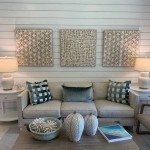Coordinating Fabrics Home Decor: Essential Aspects to Consider
Coordinating fabrics in home decor plays a vital role in creating a cohesive and visually appealing space. By carefully selecting and combining fabrics with different textures, colors, and patterns, you can achieve a harmonious and inviting atmosphere in your home. Here are some essential aspects to consider when coordinating fabrics for home decor:
Color Schemes
Color plays a crucial role in setting the tone and ambiance of a room. When coordinating fabrics, it's important to consider the color scheme you want to achieve. Start by choosing a dominant color as the base and then select complementary or contrasting colors to add depth and interest. Avoid using too many different colors, as this can create a cluttered and overwhelming effect.
Textures and Patterns
Textures and patterns add visual interest and depth to a room. When combining fabrics, consider the mix of textures, such as soft and plush velvets with smooth and crisp linens. Patterns can also create drama and personality; however, ensure they complement each other and don't compete for attention.
Scale and Proportion
The scale and proportion of fabrics affect the overall look and feel of a room. Large-scale patterns can create a bolder statement and are suitable for spacious rooms, while small-scale patterns can create a more subtle and intimate atmosphere. Consider the size of the room and furniture when choosing fabric patterns and scale.
Function and Purpose
The function and purpose of the room should also be considered when coordinating fabrics. Fabrics that are durable and easy to clean are ideal for high-traffic areas, such as living rooms and kitchens. In bedrooms and bathrooms, softer and more luxurious fabrics create a more restful and inviting ambiance.
Balance and Symmetry
Achieving balance and symmetry is crucial in creating a cohesive and harmonious decor. Use fabrics with similar weights and textures on opposite sides of the room to create a sense of equilibrium. You can also create visual symmetry by mirroring the arrangement of patterns and colors on furniture and accessories.
Transition and Flow
To create a seamless and cohesive flow throughout your home, consider transitioning fabrics from one room to another. Use similar color schemes and textures to connect different spaces and create a sense of coherence. By using fabrics as a connecting element, you can achieve a harmonious and inviting atmosphere throughout your entire home.

Coordinating Upholstery And Drapery Fabrics

How To Coordinate Our Outdoor Fabrics Decorate Furniture Cushions Fabric Decor

My Simple Formula To Coordinate Fabrics Porch Daydreamer

Fabric Design Pattern Decor Designer Fabrics Interior Services E Decorat Mixing Patterns

How To Mix Patterns Like A Pro

30 Types Of Fabric Patterns Simple Guide To Your Interior Decoration Needs

Coordinating Fabrics Fabric Decor Home

Dining Chair Plan Combining Patterned Fabric And Solid Vinyl Addicted 2 Decorating
The Ultimate Fabrics Guide To Elevate Your Interior Design Paolo Moschino

How To Co Ordinate Fabric And Wallpaper Tm Interiors Ltd







